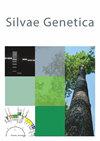利用转录组数据开发极度濒危针叶树(柏科)的微卫星标记
IF 1
4区 农林科学
Q3 FORESTRY
引用次数: 5
摘要
摘要松柏科(Glyptostrobus pensilis)是一种分布于中国、老挝和越南的极危针叶树,仅在少数种群中被发现。在此,我们的目标是开发可用于研究该物种遗传变异的微卫星标记。利用转录组数据,我们在16份样本中检测了170个SSR位点的多态性。选择23个多态性位点,对来自3个中国群体的83个个体进行遗传分析。每个位点和群体的等位基因数为1 ~ 8个,观察杂合度Ho = 0.00 ~ 1.00, He = 0.00 ~ 0.83。三个种群中至少有一个有15个位点偏离Hardy-Weinberg平衡。大部分基因座在4个近缘种(cryptoeria fortunei、Taxodium distichum、Taxodium ascendens和Cunninghamia lanceolata)中也能成功扩增。这些发育好的微卫星适合于对草芥及其近缘种进行群体遗传研究。本文章由计算机程序翻译,如有差异,请以英文原文为准。
Development of microsatellite markers for the critically endangered conifer Glyptostrobus pensilis (Cupressaceae) using transcriptome data
Abstract Glyptostrobus pensilis (Cupressaceae) is a critically endangered conifer which occurs in China, Laos, and Vietnam where it is only known from a few populations. Here we aim to develop microsatellite markers which can be used to study the genetic variation within this species. Using transcriptome data we tested 170 SSR loci for polymorphism in 16 samples. Twenty-three loci were polymorphic and selected for the genetic analysis of 83 individuals from three Chinese populations. The number of alleles per locus and population ranged from one to eight, the observed and expected heterozygosity from Ho = 0.00-1.00 and He = 0.00-0.83, respectively. Fifteen loci deviated from Hardy-Weinberg equilibrium in at least one of the three populations. The majority of loci could also be successfully amplified in four related species, namely Cryptomeria fortunei, Taxodium distichum, Taxodium ascendens and Cunninghamia lanceolata. These developed microsatellites are suitable for population genetic studies of Glyptostrobus pensilis and related species.
求助全文
通过发布文献求助,成功后即可免费获取论文全文。
去求助
来源期刊

Silvae Genetica
农林科学-林学
CiteScore
2.20
自引率
10.00%
发文量
10
审稿时长
3 months
期刊介绍:
Silvae Genetica is an international peer reviewed journal with more than 65 year tradition and experience in all fields of theoretical and applied Forest Genetics and Tree breeding. It continues "Zeitschrift für Forstgenetik und Forstpflanzenzüchtung" (Journal of Forest Genetics and Forest Tree Breeding) founded by W. LANGNER in 1951.
 求助内容:
求助内容: 应助结果提醒方式:
应助结果提醒方式:


